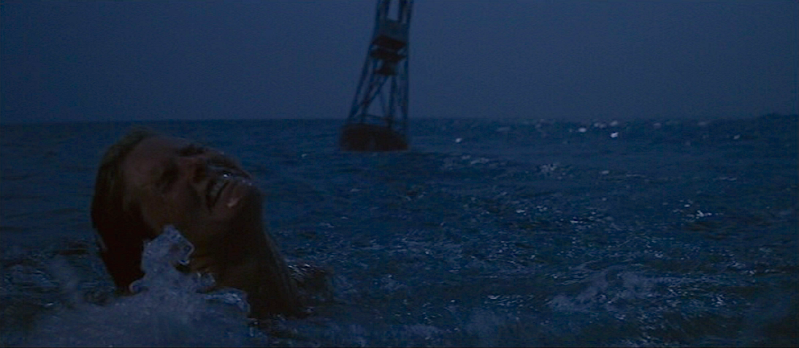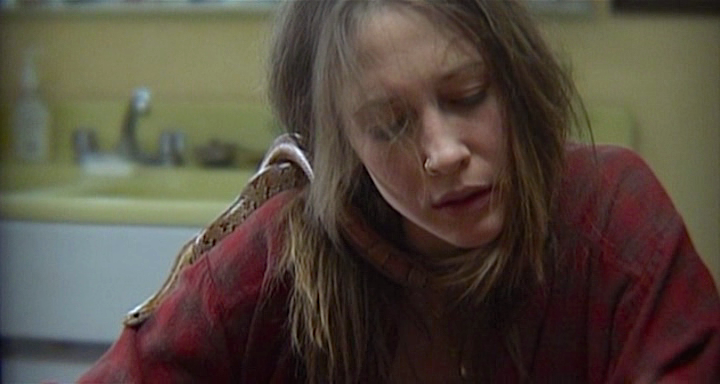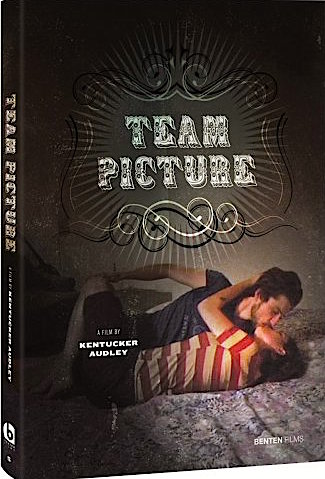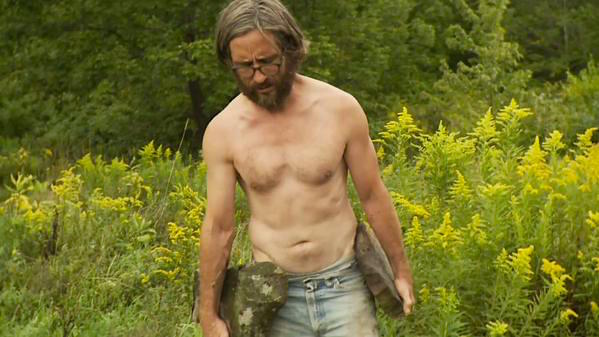Please Note: The validity of the information I’ve translated in the following post must be viewed as conjecture. Time and emotional perspectives seem to distort, amplify and confuse “fact” into varying degrees of truth, unfairly skewed opinion, and incorrect analysis. Sadly, old grudges, resentments and jealousies can lead “logic” to “mythologic.” The fact is that a number of people who were directly involved in a specific situation often remember it differently. What they have adapted to “truth” is sometimes little more than gossip. It is a challenge to determine how to look back in cinematic history. I’ve done my best to “filter” through the questionable to include what is most likely true. Please be aware that my “filtering abilities” are very limited in scope. It is not my intention to play into or further tighten untruth.
“Gossip is the opiate of the oppressed.” — Erica Jong
In the Robert Altman’s 3 Women, Shelley Duvall gleefully informs Sissy Spacek, “This is my parking space. It’s the best one!” Later Duvall explains, “That’s Dirty Girtie! Pull her bow and she’ll say hello!” …her delivery of those lines creates an odd and varied response for viewers. Some giggle, some laugh, some are not sure how to react, but many viewers feel the need to squirm.

“1 woman became 2/2 women became 3/3 women became 1”
3 Women
Robert Altman, 1977
Cinematography | Charles Rosher Jr.
When 3 Women debuted, nearly all of the major critics swooned. But the most powerful Film Critic of the day, Pauline Kael, truly disliked the movie. Her negative viewpoint of this film is of particular interest because up until this movie, Kael had been a consistently staunch Altman ally. When 20th Century Fox released it into cinemas, audiences were either entranced, confused or indifferent. In 1977 there was no Internet. There were no cell phones. While many people took the time to read serious film criticism, access to “Art Films” was largely limited to major cities like Manhattan, Boston or Los Angele. Before any sort of “word of mouth” regarding Robert Altman’s surreal experimental film had the chance to spread, it was pulled out of circulation within 8 days. Over the following two decades 3 Women became not only a “Cult Classic” but was largely considered one of the most important American films of the 1970’s. Yet only a very few had ever actually seen an uncut or clear presentation of the film.

Shelley Duvall improvises Millie Lammoreaux with an mid-mix of comedy and looming horror. Welcome to Robert Altman’s dream turned to film.
3 Women
Robert Altman, 1977
Cinematography | Charles Rosher Jr.
Robert Altman’s study of identity, isolation, loneliness and sexuality is pure cinematic magic. Shelley Duvall and Sissy Spacek are pitch-perfect. The cinematic experimentation employed is fully realized. Altman had a strange dream. He then brought it to life allowing his two key actors the freedom to improvise and create their individual visions which could blend with his. Sissy Spacek is outstanding in the film, but it is Shelley Duvall who remains the film’s vital core.

“You’re the most perfect person I’ve met.”
Sissy Spacek prepares to take aim.
3 Women
Robert Altman, 1977
Cinematography | Charles Rosher Jr.
If you’ve not seen it, prepare yourself for a film completely different and oddly disturbing. Were it not for the help of Altman and the dedication of some folks at Criterion, 3 Women might have been forever lost in an abbreviated and muddy form of a memory. In 2004, just two years prior to Altman’s passing, it was finally properly restored and placed within the correct ratio. There are more than a few people who hated it when it was released for brief week in 1977 who now find it hard to believe that they didn’t like it. Most interestingly, a lot of viewer’s who parodied Shelley Duvall’s carefully articulated “Millie” discovered there was a great deal more to her artistry than realized via YouTube and scruffy VHS tapes revealed.
Shelley Duvall has been the victim of gossip and collective mythology. Duvall is not insane. Rest assured she is not wandering around the heat of Texas trying to runaway from UFO’s. People actually believe these ridiculous rumors. The truth is that Shelley Duvall just tired of the pressures of the business. After a great deal of success creating a television series that artfully retold fairy tales, she decided to focus her attentions

“I had the most wonderful dream…”
Sissy Spacek / Shelley Duvall
Robert Atlman, 1977
Cinematography | Charles Rosher Jr.
to the care and promotion of animal rights. As the 1990’s came to a close, she relocated permanently back in Texas. She likes her privacy, but she is not a recluse. She remains an endearingly eccentric but highly intelligent woman. It would have been interesting to gain her perspective regarding the production and her experience of 3 Women and subsequent reception. It was out of respect for her wishes to go under the radar of “celebrity” that she did not take part in Criterion’s restoration or release. But Shelley Duvall will always hold a fascination of the collective consciousness. 3 Women and The Shining remain her most studied work. You would be hard pressed to think of two more oddly-effective performances in two films that hold a great deal of power in film lore.
It is challenging to even attempt to articulate how difficult it often is to secure these “lost” or “forgotten” films. My reaction to the stubborn dedication to find these films: “Man, it is really cool she loves this movie so much she is willing to devote several years trying to secure the rights to restore and distribute it.” At the same time, I do get it.
The logic is found in answers to questions like: What draws us to movies? What is about a particular movie that makes it important? Why do some important works of Film Art fail to gain notice when first released? How do important films get lost? What makes you want to watch a movie more than once? What is in this movie that resonates for you? What lost cinematic treasure would you be willing to pay $30 to own on blu-ray?
And then, come the questions from the organization that needs to fund the pursuit: What makes you think that a re-master/re-transfer of this movie will yield profit? Are we sure that the people who made this movie are willing to encage or revisit the failure of this movie? What makes you think that this person wants to remind people of this movie flop? Don’t you know that the person who needs to be involved in this re-issue is incredibly difficult? Are you not aware that this person is insane? Why do you think anyone in this century would be interested in those filmmakers? If this movie is important, why haven’t I heard of it?

“Well, here we are on the road.”
“Yup, that’s where we are all right.”
Two-Lane Blacktop
Monte Hellman, 1971
Cinematography |
Jack Deerson
Long out of circulation and “non-distributable” because of disputes over music rights, all it really took were several people who loved Two-Lane Blacktop to swerve around obstacles and navigate challenges with the kind of dedication the two lead characters apply to drag racing. But this amazing film was eventually transferred to HD/Blu-ray via The Criterion Collection. Monte Hellman’s film is so effortlessly brilliant, it is hard not to wonder if he had any idea that what he was filming would result in a cinematic masterpiece.
What at first appears to be a vague character study of two dudes drag racing their way across the country slowly develops into a surprisingly insightful art film. In truth, the movie offers only 2 characters: The primer-coated / souped-up ’55 chevy and the lonely landscape of late 1960’s America. And of the two, only one of these is fully formed. The only reliable thing “The Driver” and “The Mechanic” have in life is their powerful American car and a shared need to speed.

“You can never go fast enough…”
Dennis Wilson, Laurie Bird and Jame Taylor
Two-Lane Blacktop
Monte Hellman, 1971
Cinematography | Jack Deerson
Monte Hellman captures a country sad, detached, lonely and half asleep. With the gift of hindsight, it seems as if Hellman’s US is falling asleep as culture slips into a stew of sexual experimentation, identify assertion, self-absorption and paranoia. As we ride alongside these two half-formed men and the free-willed woman they have picked up — we see a world of loneliness, suspicion and isolation. It is all very minimalist in approach, but unbelievable in power.
The challenges involved in securing music rights often appears impossible to resolve. But that worry seems easy when encountering other concerns that greet the initial decision to pursue acquiring the rights to remaster, adjust and transfer a film to the 21st Century HD formats. If the initial line of questioning is met and a firm decision is made to fund the pursuit — a whole slew of new obstacles come up that will lead to a dead end.
While a major studio may have owned distribution rights in the film’s era, it usually has no has valid ownership today. But the majors have the power and the influence. Even though former and infamous studio leadership is long gone, there can be resentments and very real grudges that are still seething just beneath the surface. Sometimes, power never forgets. But most often the biggest challenges arrive in securing the trust of some or one talented key artist(s) who have not only secured the rights to some of their own films — they often have one of the very few near-pristine mint copies safely sealed away.

“The earth is my body; my head is in the stars.”
Harold and Maude
Hal Ashby, 1971.
It would not be until 2012 that Criterion was able to get this film re-issued in the quality it deserved.
A more challenging situation is when the key artist(s) are no longer living and control has been handed over to an individual, an estate or some other entity. A wide spectrum of potential problems arise. The family of the deceased artist(s) have unrealistic expectations of monetary value. Or for one reason or another is unwilling to discuss the topic. This situation is almost hopeless unless another “key” player in either the film’s history or is somehow “connected” to the individuals not interested is willing to step-in and put in a good word.
When looking back at the restoration and re-distribution of many films, the use of then popular songs playing in the background of a scene is particularly difficult. To provide a fictional example: If Madonna’s Papa Don’t Preach plays for over 20 seconds, an agreement much be reached with the artist or company who owns the rights to the original recording. While it might seem a minor detail that a filmmaker chose to play 65 seconds of Madonna’s Papa Don’t Preach in a movie. For the filmmaker and to the fans of the film, those 65 seconds of Madonna’s pop song are vital. Unless the artist or the publishing company is willing to cut a break this can grind the whole process to a stop. In truth, the reality is usually that if one of the individual’s pursuing the film is able to connect with either the artist or someone close to that artist. The problem can often be resolved.
While some artists are truly difficult and unreasonable, most are not. And it is usually the artists who have been most often labeled “difficult” or “unreasonable” are often the easiest and logical people you will encounter. The mythology of gossip is more important to perception than reality. Chances are Madonna has no idea that a few seconds of an old song are blocking the release of a movie. And why would she? The real challenge? …finding a way to contact Madonna without causing her alarm.
Yet something within these films requires the lover(s) of film to push in pursuit of creative ways to secure the opportunity to restore/reissue the movies. Even when everyone and everything tells them “No Way!” There are always individuals who refuse to give up the pursuit. But sometimes the pursuit almost seems like an exorcise in self-torture. Some “challenges” can’t be predicted or expected.
A highly respected and sought-after film released over 40 years ago remains a “soft spot” for some of the artists involved. This important 1975 movie still stirs powerful feelings among several powerful senior members of The Hollywood Machine. The importance of Hal Ashby’s contribution to Film Art is not to be underestimated. He was a master of capturing his era with no concerns regarding the problematic aspects he might discover. This is one of the many reasons his films have retained power. Ashby had the ability to turn the camera on his era, the characters roaming within it and the odd logic applied to choices and actions. His films never manipulate or hold the audience hand. They simply roll out in vivid simple complexity.
And now I enter the void of “filtering” information. I hope what I have come to understand is accurate, but it is very important to note that several artists of note have wildly different perspectives of a film to which they are tied. That being said, I doubt that much of this will be news to many people who have wondered why this film has never been treated appropriately.
When Warren Beatty hired Hal Ashby to take on the role of director for Beatty and Robert Townes’ incredibly smart script in 1974, he knew what he was doing. The film that would become Shampoo was a serious examination of ambition, sexual opportunism, misogyny, politics, fear, rage, loneliness and ultimate self-loathing disguised as a sex comedy. At this point one can only theorize why Beatty/Townes decided to set the movie in the Hollywood of 1968. It would seem obvious. When it comes to modern history, 1968 is one of if not the most important years that Post-WWII United States has ever experienced. Shampoo could most certainly be viewed as a realistically scathing study of that moment in time. However, it might be more likely that the decision for setting it in 1968 was a bit more personally complicated.

Julie Christy as Jackie. Her career seems to have stalled. So her hairdresser reminds her of erotic pleasure and gives her new “do” to hopes of propelling an image change. While true to late 60’s glam, does it not remind you of a certain movie star’s early 60’s “do”?
Shampoo
Hal Ashby, 1975
Cinematography | László Kovács
The origins of Shampoo‘s plot have always been a bit sketchy. Dependent upon which “sources” you feel are more accurate, Shampoo takes an oddly superficial motivation. The filmmakers, or a few of them, have stated that the story was “loosely inspired” by two notable hairdresser of that time. Discussion regarding this matter has always been approached cautiously. It is more than likely that one particular hairdresser is being parodied. And, more than a few people of influence in the early 1970’s were referenced within the characters. While several individuals who suspect that they were hidden inside “characters” no longer care if this was true or not. Some very much do still care. As for the hairdresser who may or may not served as the inspiration for Warren Beatty’s character — it’s a problem. But it is best to not go there.
Shampoo achieved a great deal of success. Both a critical and box office hit, the movie also secured an Oscar for Lee Grant. And Grant really rocks the screen in Shampoo. Interestingly, Grant’s further career pursuits seem to have instantly become limited after she received the trophy. Like many supporting actors honored with the Oscar, she sort of fell off the map. The success of Shampoo was more than earned, but it did cause some panic within the rank and file of 1975 Hollywood. More than a few “important” people felt that they were seeing themselves portrayed unfairly. Whether they were correct in that feeling is not clear. But for a movie of such success and esteem, it seemed to take a very long time to find its way to VHS and even longer to make it to DVD. When it was released to DVD, it was given the barest of transfer improvements. Actually, the only improvement was to present it in “letter box format” It didn’t look much better on DVD than it had in an already lazy transfer to VHS. Columbia Pictures/Sony no longer own the distribution rights. However, Sony still retains a vested interest in Shampoo that is difficult to clearly define. It has never been restored and transferred to HD/blu-ray quality. Note: It is not for lack of trying. It is unclear if Shampoo will ever be pulled out of the complex mire that keeps it restrained. Yet the pursuit pushes onward.
Another film from the 1970’s which has slowly began to be “revisited” from a Film Theory / Cinematic History perspective is far more obscure than Shampoo. This other film was released in 1972. It was independently financed by a very powerful actor/singer who wanted the opportunity to make a film which more personally expressed the ways in which the cultural/societal ideals of rigid Feminism were causing a confusion of female identity. This artist was and remains one of the most misunderstood public figures in entertainment history.
Barbra Streisand was not yet 30 but was already labeled “iconic” and “superstar” and she was the actor/singer. The movie she wanted to make was Up The Sandbox. It was based on Anne Roiphe’s 1970 novel. Up The Sandbox is a particularly interesting example of the way unexpected obstacles block the ability to secure distribution rights and release in HD quality to blu-ray. Once again, it is here that it is often hard to sort out “truth” from “distorted opinions” and tacky old gossip.
In the late 1960’s many bankable film stars began to feel the major studios were consistently limiting their artistic abilities and interests. It was then super-agent, Freddie Fields, who came up with an idea for for Barbra Streisand, Sidney Poitier and Paul Newman. He suggested that the 3 iconic artists join together to form a new kind of film production company which would give all 3 creative power in the films they chose to make. As all 3 knew each other fairly well, Freddie Fields felt that each of the four actors trusted each other’s individual visions. They agreed.

Film Icons McQueen, Streisand, Newman and Poitier join together to form First Artists. Hollywood, 1969.
Photographer | Unknown to me
Streisand/Poitier/Newman all had the shared goal of controlling their film carriers. In less than a year, Steve McQueen joint the 3. A bit later Dustin Hoffman joined them as the 5th. McQueen/Hoffman also shared the same opinion that the major studios “did not get” who they were or what they could do as actors, producers and directors. Each of them would take on the sole responsibility for each of his/her respective film(s) that they would co-jointly fund. They also committed to produce three films each. There appear to have been other details involved how the partners would reach a consensus to “green light” each project. But I’m uncomfortable in assessing the validity of the information related to this aspect of the artists’ agreement. But it does seems to have been more of a “safety net” that these 4 movie stars secured a co-deal which made First Artists a subsidiary of Warner Bros. Interestingly, Warner Brothers seemed hesitant to serve as the distributer for films made by First Artists. National General Pictures was a new distribution company that initially distributed the first several films. Within barely 2 years, NCP was cited for Anti-Trust infringement and was shut-down. At that point WB started distributing First Artists Productions films.
But the initial spirit of United Artists became muddled fairly early in. It seems clear that McQueen liked all of his fellow partners, but he did not agree with their strongly shared political left-wing opinions. McQueen great deal of trouble securing “buy-in” or “agreement” for to pursue the scripts he wanted because they did not reflect what the other 3 artists felt their shared films should reflect. Later on, Dustin Hoffman ran into challenges with not only McQueen but Paul Newman over several projects he wanted to pursue. It is almost impossible to know what actually happened, but one of the aspects of First Artists that continues to surface, Streisand often calm situations. While strident in her political and civil rights concerns — she didn’t seem to feel the need to make that an essential aspect of the production company. It has been noted that of the 5, Streisand had the most logical business approach: The individual artist should be granted more control, but the bottomline had to be met. In other words, she might not have been particularly interested in seeing McQueen’s The Getaway, but she understood that McQueen knew what he was doing and that his film was likely to be a hit. A clear pattern seems to emerge that Streisand had a clear understanding of the reality that First Artists had to turn profits. Freedom of control would not amount to much in the big picture if monetary success was not achieved. It seems that both Newman and Poitier understood this, but were less concerned.
Unlike many of the film production companies that would spring up throughout the late 1980’s/1990’s, this was not a “tax write-off” or a way for actors to make more money on any film in which he/she stars. This was a legit attempt at taking control of their “individual” and “shared” artistic “visions.” First Artists managed to create minor box office hits, but only three significant money-makers: Steve McQueen’s The Getaway was the first major hit earning an initial $37,000,000 and later approaching $50,000,000 with worldwide distribution with a budget of only $4,000,000. Both the budget and the box-office earnings were challenged, but it seems those numbers are most accurate. McQueen’s film directed by Sam Peckinpah is now a cinematic classic, but it is not clear that it did big business during its initial release.
As it would turn out, Streisand was the only of the 5 artists who was able to deliver major commercial hits. Despite an epic pan by critics, her 1976 A Star Is Born earned $80,000,000 and continued to higher profits via world wide distribution. Though it is difficult to fully know what a film earned back in the 1970’s, it is thought that A Star Is Born earned well over $100,000,000 by the end of 1977. With a budget of 6,000,000 this would be the only “blockbuster” First Artist would ever produce. Her 1979 movie, The Main Event, once again escaped film critic’s disdain when it earned $43,000,000 with a budget of only $8,000,000. Once again it would earn closer to $50,000,000 via world wide release and had secured “blockbuster” status by early 1980. With only three major hits in eleven years, First Artists folded by the end of 1980.
The first two films released were from Paul Newman: Pocket Money and The Life and Times of Judge Roy Bean. Both of these films were released in 1972. Pocket Money failed to make money and was greeted negatively by the critics. The Life and Times of Judge Roy Bean, directed by the great John Huston, initially failed to make money, but critics quite liked it. It also earned an Oscar nomination for “Best Song” and several Golden Globe nominations. This would help it to eventually earn $7,000,000 in 1973. However, the actual budget for Judge Roy Bean remains a mystery. For reasons related to concerns over who would direct, First Artists ended up paying what was then termed “a record price” to secure the rights to John Milius’ script. It must have been a true record price because First Artists and Warner Bros. viewed it as a box office loss.
Up the Sandbox would be Barbra Streisand’s first venture into the world on the other side of the camera. It would also be the third film First Artists made and released. Up the Sandbox would actually earn some of the best reviews Streisand had yet to receive from serious film critics — most importantly, Pauline Kael. Similar to Paul Newman’s Judge Roy Bean, Streisand’s first venture started out with a modest budget. Once again, sorting truth from fact is difficult.

“If this is what being a mother is like, I turn in my ovaries!”
Barbra Streisand
Up The Sandbox
Irvin Kershner,1972
Cinematography | Gordon Willis
Streisand wisely asked Irvin Kershner to helm as director. He was her first choice and he accepted immediately. Streisand had a deep respect for Kershner and he for her. As the two began to plan and work with Paul Zindel and his adaptation of the novel to screenplay, Streisand was pressed to increase the budget. The actual truth is not clear, but it appears that Kershner’s vision was more ambitious than Streisand’s. He felt it was important to treat her character’s reality and fantasies in the same way. In other words, he was interested in applying a higher level of Surrealism than Zindel captured in his original draft. Among Kershner’s ideas was to film several scenes of the movie in Africa. During post-production, the expensive African shoot was hardly used in the final cut. He also agreed with Streisand that Gordon Willis was the best cinematographer working. Willis’ dance card was full at this time and he wasn’t just any cinematographer. But he accepted the offer and was hired. Eventually Streisand increased her film’s budget to $5,500,0000. Streisand fully supported her director and their cinematographers’ instincts. And it bears noting that she still agrees today. She appears to have no regrets regarding Up the Sandbox. But it would be her first cinematic flop. Sandbox earned only $3,500,000. The fact that her film flopped had a more potent impact on her “cred” than the even more substantial losses suffered by her business partners. This is most certainly fact. It can’t be disputed. Hollywood’s infamous “Boy’s Club” was less forgiving toward Streisand than her male business partners. Thus ended Streisand’s attempt with experimental cinema.
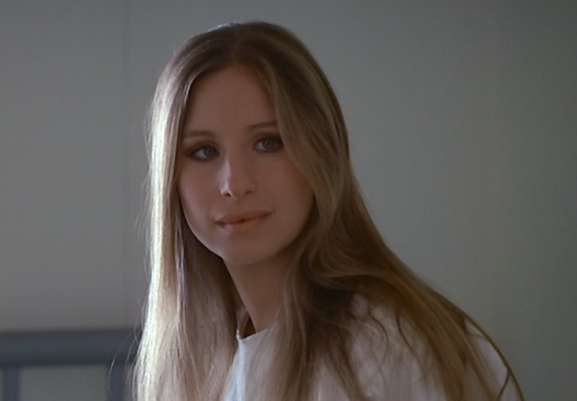
Fantasies and Mundane Reality merge
Barbra Streisand (without a wig or a net)
Up The Sandbox
Irvin Kershner, 1972
Cinematography | Gordon Willis
Up the Sandbox is dated, but it is an exceptionally interesting surreal experimental film. This not a typical Streisand film. Zindel and Kershner approached the line between realism and fantasy in ways that create a disarming sense of disorientation. What at first appears to be a fairly clear way of fusing reality into fantasy gradually becomes unclear. It is becomes difficult to know when what we have seen is real or fantasy. As the mid-point of the movie arrives, the viewer begins to suspect or wonder if what was “perceived” as a fantasy at the beginning of the film might have actually been “real”

Streisand and her lover head out to express political anarchy through terrorism.
Up the Sandbox
Irvin Kershner, 1972
Cinematography | Gordon Willis
This is achieved by slightly changing the “style” when it comes to some outlandish fantasies and applying an almost passive focus to other fantasies. The character’s reality veers into several shifts of style as well. By the time the credits begin to roll, the audience is no longer sure what has been “real” and what has been “fantasy” This intended confusion actually becomes stronger when the viewer has a bit of distance from the film itself. Irvin Kershner crafts the film in a manner that compels repeated viewings.
There was a strong and often confused political stance regarding Feminism of the late 1960’s and early 1970’s. Many of the Feminist Goals seemed to have applied pressure on many women for whom these goals were not always the optimal choice within the context of daily everyday life. Up the Sandbox‘s main character is bored and constantly trying to determine where she stands in a world filled with political and sexual revolution. She is feeling uneasy and confused by a growing level of cultural pressure and expectations regarding her own female identity. Her decision to put her “career” on the back-burner to stay at home and raise her children turns a quite valid decision at odds with the culture she navigates. With the gift of hindsight, the main character’s conflict with The 1970’s Feminist Movement blended with the cinematic experimental style makes Up the Sandbox seem like a very odd career choice for Barbra Streisand both as a producer and a highly politicized public person. It also adds a distinctive underlined power to the movie.
Film critics met the movie with mixed responses. Some loved it. Some were confused. But only a handful of critics disliked it. Perhaps most significant of this era, Pauline Kael gave Streisand praise for taking on and succeeding at playing a character so far from public perceptions of Streisand. First Artist Productions and National General Pictures were equally conflicted about how to market the movie. The decision was to promote the movie as a “comedy” utilizing a Richard Amsel illustration of a pregnant Streisand tied to a baby bottle on the cover of Time Magazine declaring Streisand to be “The dust mop of the year!” It was an odd and misleading choice. By the time it reached cinemas Streisand fans were expecting an R-rated version of What’s Up Doc? — instead they found themselves watching an experimental film featuring a version of Streisand they had not seen. There were few wise-cracks. There was no glam. Streisand had not worn a wig for What’s Up Doc? but Peter Bogdanovich ensured that her hair was well appointed for each scene — as well as make-up. Up the Sandbox presents Streisand without a wig and the benefit of constant grooming and Gordon Willis applied a natural lighting when he shot her. This was Streisand “acting” and she is believable as an upper-middle class housewife of a middling academic with two children. There were very few typical funny scenes. The humor most often takes the tone of Absurdism. The marketing error is that this was film for Art House Cinemas and it should have been marketed to express that. However, even Pauline Kael’s positive assessment wasn’t enough to make Film Art supporters believe they should bother seeing the movie.
The film also fueled anger from the left. Vito Russo, a crucial Gay Rights Advocate, was very quick to criticize a liberal with strong ties to the gay community for allowing her character to say a line during what turns out to be a potential lesbian experience. Streisand’s repressed character’s response is still disturbing. Feminist were angered by this scene and were also frustrated that an ally of The Feminist Movement would even hint at playing a character who is conflicted by anything related to Feminist philosophy. But the mainstream had already ignored the movie before any of these controversies were discussed.
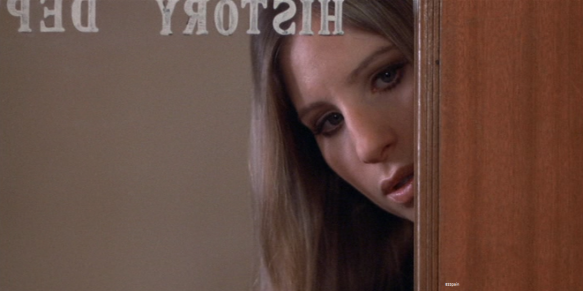
Are we sure she is actually seeing that?
Barbra Streisand
Up the Sandbox
Irvin Kershner, 1972
Cinematography | Gordon Willis
Streisand over-saw the remaster of Up The Sandbox to DVD and Warner Bros released it as a part of DVD box set in 2004. It features a commentary from Streisand as well as Irvin Kershner. Streisand’s commentary is not particularly insightful. The main “take away” is that this film was very important to her, she remains proud of the movie but seems genuinely “bruised” by its failure. As she provides her commentary it almost seems like we are hearing a tired mathematician trying to determine the answer to a difficult equation. Irvin Kershner’s commentary is more relevant. He touches on the fact that at the time they were filming, friends warned him to not to share some concerns he began to have in mid-production. He took that advice. Long after the film was completed and released, he shared this with Streisand. Both commentaries make it clear that the two were and had remained friends. Kershner discovered that Streisand was hurt that he hadn’t trusted her enough as the producer to bring his concerns to her attention. The experience of this film’s commercial failure would forever change the way Streisand approached projects. It also resulted in over 2 years of unemployment for Kershner. As he once stated, “It’s not so easy to be the only filmmaker to direct a Barbra Streisand movie that flops.”
The other 3 DVDs initially only sold as a set with Up the Sandbox were soon offered for purchase individually. Up the Sandbox was the lone non-seller of the set.
Over the past decade this movie has started to gain the attention of number of Film Theory and Film Historians. It seems potentially posed for critical re-evaluation and an ideal time to properly restore the film. It would seem the current challenges are more tied up in confusion about distribution rights and a general mistrust that anyone would buy the blu-ray or HD stream. So the current situation is making the case for Up The Sandbox as a valid and important film. It is a great snapshot of a woman caught in the unique Cultural Web that was spun out of the 1960’s. I recently received an email from one of the people most vested in getting this film restored. She wrote: “The film actually feels more French than American. And yet it is filled with idiosyncratic use of ‘nameless’ iconic pop culture figures…” She is referring to Up the Sandbox‘s odd assortment of easily recognized but somehow forgotten actors. Most of the minor supporting roles are played by soon to become key players in some very iconic television. Much of TV’s The Jeffersons, Electric Company, Laverne & Shirley, One Day At A Time and other soon-to-be-famous 1970’s TV show actors are present. Most notably, this was Stockard Channing’s film debut. It does sort of add an additional aura of disorientation.
The other “selling points” are that the film speaks to the skill of Irvin Kershner, a great filmmaker who never gained the respect he deserved. He was very much apart of the whole new American filmmaking era that gave us such artists as Altman, Ashby and Arthur Penn. History has largely relegated Kershner to being the director who got into arguments with George Lucas as he directed sequel to Star Wars. Apparently Kershner’s idea of adding “a bit more depth” was a daunting challenge for the director of Return of the Jedi. He was an odd pick for that movie and it seems strange that this is the film for which he is remembered. Additionally, Gordon Willis added his brilliance as cinematographer. Up the Sandbox appears to be a lost, forgotten and under-appreciated cinematic curiosity. But it has several key players in the world of film restoration trying to find ways to secure distribution and they are determined.
The whole world of The Film Art Restoration/Release and that of the Boutique DVD/Blu-ray fascinates me. It has also holds a seductive power. I’m intensely curious why certain movies mean so much to people. This is one of the many magic aspects Film Art. It is subjective, but is seems to stir an incredible level of passion. I find it inspirational to see that initial individual who starts the initial journey to restore a film and manages to succeed. And usually even if I’m not particularly interested in the movie, their commitment to these films resonates for me.
Matty Stanfield







